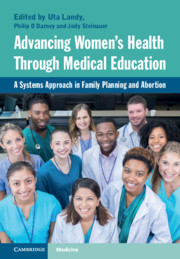 Advancing Women's Health Through Medical Education
Advancing Women's Health Through Medical Education Book contents
- Advancing Women’s Health Through Medical Education
- Reviews
- Advancing Women’s Health Through Medical Education
- Copyright page
- Dedication
- Contents
- Contributors
- Preface
- Acknowledgments
- Introduction
- Section I Abortion Training: Workforce, Leadership, Social & Political Impact
- Section II Integration of Abortion into Graduate Medical Education
- Chapter 9 Abortion Training in the USA
- Chapter 10 Starting and Optimizing an Academic Abortion Service
- Chapter 11 The Role of Early Pregnancy Loss Care in Ensuring Competence in Uterine Evacuation
- Chapter 12 Academic Family Planning and Sexual and Reproductive Health Collaborations
- Chapter 13 Family Planning Training at Catholic and Other Faith-Based Hospitals
- Chapter 14 The Importance of Including Abortion in Undergraduate Medical Education
- Chapter 15 Integrating Sexual and Reproductive Health-Care Training into Family Medicine
- Chapter 16 Integrating Abortion Training into Advanced-Practice Clinician Programs
- Section III Family Planning Curricular Design & Implementation
- Section IV Reproductive Health Services & Abortion Training: Global Examples
- Index
- References
Chapter 14 - The Importance of Including Abortion in Undergraduate Medical Education
from Section II - Integration of Abortion into Graduate Medical Education
Published online by Cambridge University Press: 30 July 2021
- Advancing Women’s Health Through Medical Education
- Reviews
- Advancing Women’s Health Through Medical Education
- Copyright page
- Dedication
- Contents
- Contributors
- Preface
- Acknowledgments
- Introduction
- Section I Abortion Training: Workforce, Leadership, Social & Political Impact
- Section II Integration of Abortion into Graduate Medical Education
- Chapter 9 Abortion Training in the USA
- Chapter 10 Starting and Optimizing an Academic Abortion Service
- Chapter 11 The Role of Early Pregnancy Loss Care in Ensuring Competence in Uterine Evacuation
- Chapter 12 Academic Family Planning and Sexual and Reproductive Health Collaborations
- Chapter 13 Family Planning Training at Catholic and Other Faith-Based Hospitals
- Chapter 14 The Importance of Including Abortion in Undergraduate Medical Education
- Chapter 15 Integrating Sexual and Reproductive Health-Care Training into Family Medicine
- Chapter 16 Integrating Abortion Training into Advanced-Practice Clinician Programs
- Section III Family Planning Curricular Design & Implementation
- Section IV Reproductive Health Services & Abortion Training: Global Examples
- Index
- References
Summary
Medical educators have a responsibility to train medical students in the competencies needed to improve the sexual and reproductive health (SRH) of their communities.Abortion is not only a core component of SRH care it is also common with 56 million annually worldwide. While abortion is very safe when provided by trained clinicians, almost half (45%) of abortions are practiced under unsafe conditions leading to an estimated 7 million complications and accounting for 8% of maternal deaths each year. According to the World Health Organization (WHO), unsafe abortion can be prevented by giving women access to legal abortion by trained, competent practitioners and timely emergency treatment of complications. Significant barriers to implementing abortion laws in these settings are the lack of properly trained health personnel and lack of abortion training in medical schools.This chapter begins with an overview of medical education standards and their relevance for sexual and reproductive health. It then reviews the literature about medical student education about abortion and includes a sample of regional and national organizational recommendations. It finally describes opportunities for inclusion of abortion in medical education, using the educational objective standards set by the World Federation of Medical Education.
Keywords
- Type
- Chapter
- Information
- Advancing Women's Health Through Medical EducationA Systems Approach in Family Planning and Abortion, pp. 143 - 150Publisher: Cambridge University PressPrint publication year: 2021
References
- 2
- Cited by
